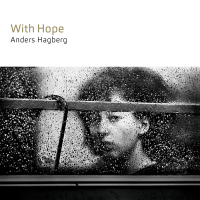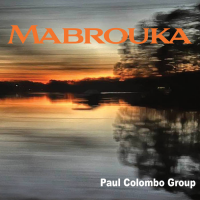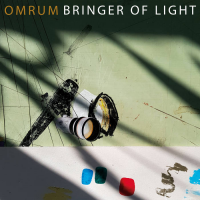Home » Jazz Articles » Multiple Reviews » Vintage Dolphy
Vintage Dolphy
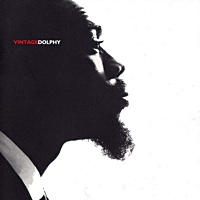 Vintage Dolphy appeared originally in 1986/7 on both vinyl and CD. Featuring recordings from three separate live performances from Eric Dolphy, two at Carnegie Hall, both with his own quartet and in two 'third stream' settings devised by Gunther Schuller, the album provided intriguing insights into Dolphy's improvisational skills and approach. Were this not enough, the 1996 edition added a jam session from the Carnegie Hall concert where the quartet tracks were recorded. Featuring a group of mainly hard-boppers performing Charlie Parker's "Donna Lee," it offered further confirmation of the reed player's unusual abilities.
Vintage Dolphy appeared originally in 1986/7 on both vinyl and CD. Featuring recordings from three separate live performances from Eric Dolphy, two at Carnegie Hall, both with his own quartet and in two 'third stream' settings devised by Gunther Schuller, the album provided intriguing insights into Dolphy's improvisational skills and approach. Were this not enough, the 1996 edition added a jam session from the Carnegie Hall concert where the quartet tracks were recorded. Featuring a group of mainly hard-boppers performing Charlie Parker's "Donna Lee," it offered further confirmation of the reed player's unusual abilities. These are important recordings that amount to much more than any number of radio shots from Dolphy's European tours. If anything, their relevance has been enhanced by the recent Resonance Records release of The Musical Prophet: The Expanded 1963 New York Studio Sessions. The tracks recorded by Alan Douglas in July 1963 and later released as Conversations (1963) and Iron Man (1968) connect in several ways with the Vintage Dolphy performances. Indeed, the latter informs and enhances our understanding and appreciation of the Resonance set.
 In several ways, Vintage Dolphy is also a tribute to two major American musical figures—Dolphy himself, and Gunther Schuller. The CD features performances from three different concerts each one curated by Schuller and appeared/appears on GM Recordings, the label founded in 1981 by him to:
In several ways, Vintage Dolphy is also a tribute to two major American musical figures—Dolphy himself, and Gunther Schuller. The CD features performances from three different concerts each one curated by Schuller and appeared/appears on GM Recordings, the label founded in 1981 by him to: ..."to unite discerning and open-minded listeners with accomplished, innovative composers and musicians who might otherwise go unrecorded."
Schuller's championing of Ornette Coleman, George Russell, Charles Mingus and Dolphy is well-known, as is his role in that New York Bloomsbury set that brought together musicians such as Charlie Parker, Dizzy Gillespie, Gerry Mulligan, John Carisi and Russell. Yet, all too often Schuller is remembered, fondly or not, by reference to the term "Third Stream." Vintage Dolphy provides an opportunity to grasp what is meant by the term but also to understand how Dolphy might connect with it.
The Schuller recordings feature three of the tunes performed in quartet that would later feature strongly on the Douglas releases—"Iron Man," "Ode to Charlie Parker" and "Half Note Triplets." The last of these was retitled as "Burning Spear" in tribute to Jomo Kenyatta, the newly appointed first Prime Minister of Kenya, an event that was a triumph for African nationalism. While these sides give far more assured and developed readings of these pieces, the Vintage Dolphy versions clearly informed the later versions. As to the Schuller pieces, these suggest possible links to the ways in which Dolphy approached the Resonance/Douglas numbers and the musical devices and approaches he used.
Beginning with the thirteen minute jam session, this is a perfectly acceptable example of the time-honoured format. Phil Woods on alto is on particularly good form, as is tenorist Benny Golson, sounding here a little like Coleman Hawkins, and trombonist Jimmy Knepper. But only trumpeter Don Ellis comes close to matching Dolphy, who succeeds in fitting in seamlessly but at the same time sounding as if he just beamed in from Alpha Centauri! He plays the changes but knows how to do so much more with them and he does this by adding extensions that allow him to play notes outside the chords. No wonder critics had such a hard time trying to pigeon-hole the guy.
Of the quartet tracks, "Half Note Triplets" is first up. It is a contained, structured piece of music-making featuring a beautifully concise bass clarinet solo from Dolphy and a good solo from trumpeter Edward Armour, whom Dolphy knew through Mingus' band. Though it feels like a work in progress, it is organized in three parts—a two-part theme contrasting slow and fast passages, followed by the solos with their powerful sense of release and finally a return to the two themes. In this setting, its very succinctness and clearly-defined structure are what makes it work.
On the Musical Prophet performance, though only another four minutes longer and now titled "Burning Spear," it has become something much wilder but also more clearly compositional. It is not just the series of solos—Dolphy, Woody Shaw, Bobby Hutcherson and the bass duet of Eddie Khan and Richard Davis—that suggest this. If we cannot talk in terms of thematic development, we can see the tune now as a series of episodes or events, defined by different musical colours and moods leading to an emphatic, clenched-fist, air-pumping, "Yes!"
 The ballad, "Ode to Charlie Parker," from Vintage Dolphy, opens with Dolphy on flute playing long notes and glisses behind Armour's brief solo, before they swap places. Dolphy's flute is as ever a thing of beauty but Armour acquits himself extremely well. The rhythm section is fluid with Richard Davis' bass playing much more than an anchoring role. The latter's solo is followed by a return of the theme with Armour leading and Dolphy shadowing him as they lead into a fade.
The ballad, "Ode to Charlie Parker," from Vintage Dolphy, opens with Dolphy on flute playing long notes and glisses behind Armour's brief solo, before they swap places. Dolphy's flute is as ever a thing of beauty but Armour acquits himself extremely well. The rhythm section is fluid with Richard Davis' bass playing much more than an anchoring role. The latter's solo is followed by a return of the theme with Armour leading and Dolphy shadowing him as they lead into a fade. That was in April 1963. By early July, "Ode to Charlie Parker" has been transformed into a flute/bass duet. This is one of four such duets on the Resonance release, though "Muses for Richard Davis" was until this point unissued. Incidentally, it is incorrectly attributed to Dolphy in the booklet accompanying the three CD set. Dolphy makes it quite clear in his announcement of the tune at Carnegie Hall that it is a tune by Jaki Byard. Such carping aside, the intimacy of the Douglas take of "Ode" is quite magnificent. By stripping it down in this way nothing is lost but, rather, the piece acquires a meditative quality missing in all other versions, including the Dolphy/Booker Little original on Far Cry, which includes its composer on piano.
That leaves "Iron Man." It opens with an eight bar introduction that is then repeated with variations from Dolphy. This by far the most confident of the Vintage Dolphy quartet tracks. Drummer J.C. Moses, who also appears on the same tune of the Resonance/Douglas set, is a tour de force here matching Dolphy, on alto, every step of the way on what is a furiously paced take. If the structure of the composition is quite simple, it is rhythmically very complex and that reveals one of Dolphy's great strengths. As critic Martin Williams noted, the saxophonist might have begun by absorbing Parker rhythmically but by this point he was very much his own man in this regard.
 The tune retains the same structure on the Resonance/Douglas version, with solos from Dolphy, Woody Shaw on trumpet, Bobby Hutcherson on vibes and bassist Eddie Khan. Surprisingly, here and elsewhere on Conversations and Iron Man, Dolphy has available four additional woodwind players. Yet, he only makes use of them on the theme at the beginning and end and then essentially to provide a drone-like effect. But again, the piece makes its point through its sheer driving, propulsive energy and, if anything, the addition of Hutcherson adds both colour and additional rhythmic possibilities.
The tune retains the same structure on the Resonance/Douglas version, with solos from Dolphy, Woody Shaw on trumpet, Bobby Hutcherson on vibes and bassist Eddie Khan. Surprisingly, here and elsewhere on Conversations and Iron Man, Dolphy has available four additional woodwind players. Yet, he only makes use of them on the theme at the beginning and end and then essentially to provide a drone-like effect. But again, the piece makes its point through its sheer driving, propulsive energy and, if anything, the addition of Hutcherson adds both colour and additional rhythmic possibilities. However, Vintage Dolphy has other stories to tell and does so through the four third stream compositions from Schuller. These tell us a lot about Dolphy's talent is ability to work within situations devised by others. It is also possible that Schuller's use of Dolphy in this context might also have reflected the former's awareness of the young musician's wider musical potential.
Two of the Schuller pieces on Vintage Dolphy—"Variations on a Theme by Thelonious Monk (Criss Cross)" and "Abstraction"—had been recorded previously on Jazz Abstractions (Atlantic). That recording took place in December 1960 but both were premiered in New York in May of that year. The latter had featured Ornette Coleman, while the former had featured both Coleman and Dolphy. Martin Williams suggests in his sleevenotes to Vintage Dolphy that, with "Abstraction," Coleman "sensed" and "sized up" Schuller's composition and then "ran a parallel course to it" in his improvisation. Dolphy, on the other hand on Vintage Dolphy, gets inside the piece, his improvisation becoming an integral part of the composition. This same sense is apparent on the later of the two versions of "Variations on a Theme" and also on "Densities" and "Night Music." Dolphy's playing elaborates upon the composer's intentions fully realising its promise.
There are two particular techniques that Schuller deploys on "Variations on a Theme" that are relevant to consideration of the Alan Douglas sides. In "Variant I," Schuller has the soloists "overlapping" in a "Relay" format, so that "one soloist's last chorus is the next soloist's first chorus." Dolphy uses the same technique, most notably, on "Iron Man" and "Burning Spear." If anything, he even extends the sonic possibilities introduced by Schuller by prolonging the overlapping of the two improvisers, albeit with one shadowing the other. This is a good example of how, in jazz, the line between improvisation and composition is frequently blurred.
The other technique that Schuller uses that is also relevant to Musical Prophet occurs in "Variant III," when the composer has Dolphy on bass clarinet duet with Scott LaFaro on bass. Solo or duo cadenzas are common in classical compositions, though less so in jazz. Following the May 1960 performance of "Variations," in November 1960, Dolphy recorded two duets with bassist Ron Carter that were released posthumously. There is no indication that Dolphy had attempted to perform or record in a woodwind/bass duo before that date. However, the wind/bass duets on the two Douglas discs—"Come Sunday," "Alone Together" and "Ode to Charlie Parker" (plus, of course, on "Musings for Richard Davis")—reveal how effectively Dolphy deployed the device and how he was able to adapt it to his needs and aspirations.
However, it is also worth suggesting that Dolphy's use of vibes on the Douglas recordings and on his masterpiece, Out To Lunch, might have owed something to his experience playing the Schuller pieces on Jazz Abstractions and Vintage Dolphy, which featured Eddie Costa on "Variations" and Warren Chiasson on "Densities." The only other recordings prior to these where Dolphy had performed with vibraphone were on the two Latin Jazz Quintet releases, where he appears as a sideman.
The use of Bobby Hutcherson on Conversations, Iron Man and Out To Lunch certainly gave Dolphy much more space and freedom as an improviser but also allowed for compositions that were more open and unpredictable. Whether or not the experience of vibes in the context of the Schuller performances, the decision to use Hutcherson certainly proved creatively fortuitous for Dolphy and it is worth considering the possibility of a connection.
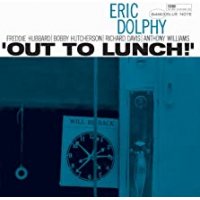 It is not just about Schuller's influence on Dolphy or the musician's deep appreciation of contemporary classical music that are most important here. We know, for example, that Dolphy performed Edgar Varèse's solo flute piece "Density 21.5" at the Ojai Contemporary Music Festival in 1962 and that Schuller helped coach Dolphy for the performance.* We also know, through Schuller, that Dolphy had been experimenting with twelve tone rows and from pianist Misha Mengelberg, who played with Dolphy in Europe in 1964, that he felt he had yet to develop fully as a composer. However, the debt of jazz to classical music is more than matched by that owed to jazz by so much twentieth century composition. It is important to dispense with any simplistic idea of Schuller as some kind of mentor or even Svengali-like figure. Theirs was a relationship of mutual respect and exchange of ideas. It is more the case that in the fifties and sixties both jazz and contemporary music were mining similar sonic territory. As to why this was the case, a whole book would be needed to offer adequate explanation. What is obvious, nevertheless, is that Dolphy was at the forefront of such musical explorations.
It is not just about Schuller's influence on Dolphy or the musician's deep appreciation of contemporary classical music that are most important here. We know, for example, that Dolphy performed Edgar Varèse's solo flute piece "Density 21.5" at the Ojai Contemporary Music Festival in 1962 and that Schuller helped coach Dolphy for the performance.* We also know, through Schuller, that Dolphy had been experimenting with twelve tone rows and from pianist Misha Mengelberg, who played with Dolphy in Europe in 1964, that he felt he had yet to develop fully as a composer. However, the debt of jazz to classical music is more than matched by that owed to jazz by so much twentieth century composition. It is important to dispense with any simplistic idea of Schuller as some kind of mentor or even Svengali-like figure. Theirs was a relationship of mutual respect and exchange of ideas. It is more the case that in the fifties and sixties both jazz and contemporary music were mining similar sonic territory. As to why this was the case, a whole book would be needed to offer adequate explanation. What is obvious, nevertheless, is that Dolphy was at the forefront of such musical explorations. Interestingly, Conversations and Iron Man feature only three Dolphy pieces. Listening to Out To Lunch after the Resonance box set and Vintage Dolphy, the sense that he was finally realising his potential as a composer is both heartening and saddening. The five Dolphy tunes on Out To Lunch reveal a composer truly reaching for something. One can certainly hear the influence of European Art Music on the record—notably Kurt Weil, Stravinsky, Alban Berg—but these are integrated timbrally, harmonically and rhythmically in a jazz context that is quite profound. One might add, coming from a different perspective, that the discursive, narrative structure of these pieces owes much to African musical traditions, albeit refracted through African-American experience, and that Dolphy's success lay in the way he fashions something wholly new from such stimuli. In a way, Vintage Dolphy points the way to both The Musical Prophet and Out To Lunch. These three sets say that there should have been, could have been so much more. But let's be grateful for what there is.
* The title of the Varèse piece relates to the density of platinum and referred to the platinum flute of flautist George Barrère, who first performed it. I have no idea whether or how the title of Schuller's composition, "Densities," performed by Dolphy on Vintage Dolphy, relates to Varèse's piece. However, Varèse spoke of "Density 21.5" in terms of the emergence of "shapes of sound." I can think of no better description of Dolphy's playing on his three instruments.
Tags
Eric Dolphy
Extended Analysis
Duncan Heining
Vintage Dolphy
GM Recordings
Eric Dolphy
Gunther Schuller
Charlie Parker
Ornette Coleman
George Russell
Charles Mingus
Dizzy Gillespie
Gerry Mulligan
John Carisi
Phil Woods
benny golson
Coleman Hawkins
Jimmy Knepper
Don Ellis
Edward Armour
Woody Shaw
Bobby Hutcherson
Eddie Khan
Richard Davis
Jaki Byard
J.C. Moses
Eddie Khan
Scott LaFaro
Ron Carter
Eddie Costa
Warren Chiasson
Misha Mengelberg
PREVIOUS / NEXT
Support All About Jazz
 All About Jazz has been a pillar of jazz since 1995, championing it as an art form and, more importantly, supporting the musicians who make it. Our enduring commitment has made "AAJ" one of the most culturally important websites of its kind, read by hundreds of thousands of fans, musicians and industry figures every month.
All About Jazz has been a pillar of jazz since 1995, championing it as an art form and, more importantly, supporting the musicians who make it. Our enduring commitment has made "AAJ" one of the most culturally important websites of its kind, read by hundreds of thousands of fans, musicians and industry figures every month.









